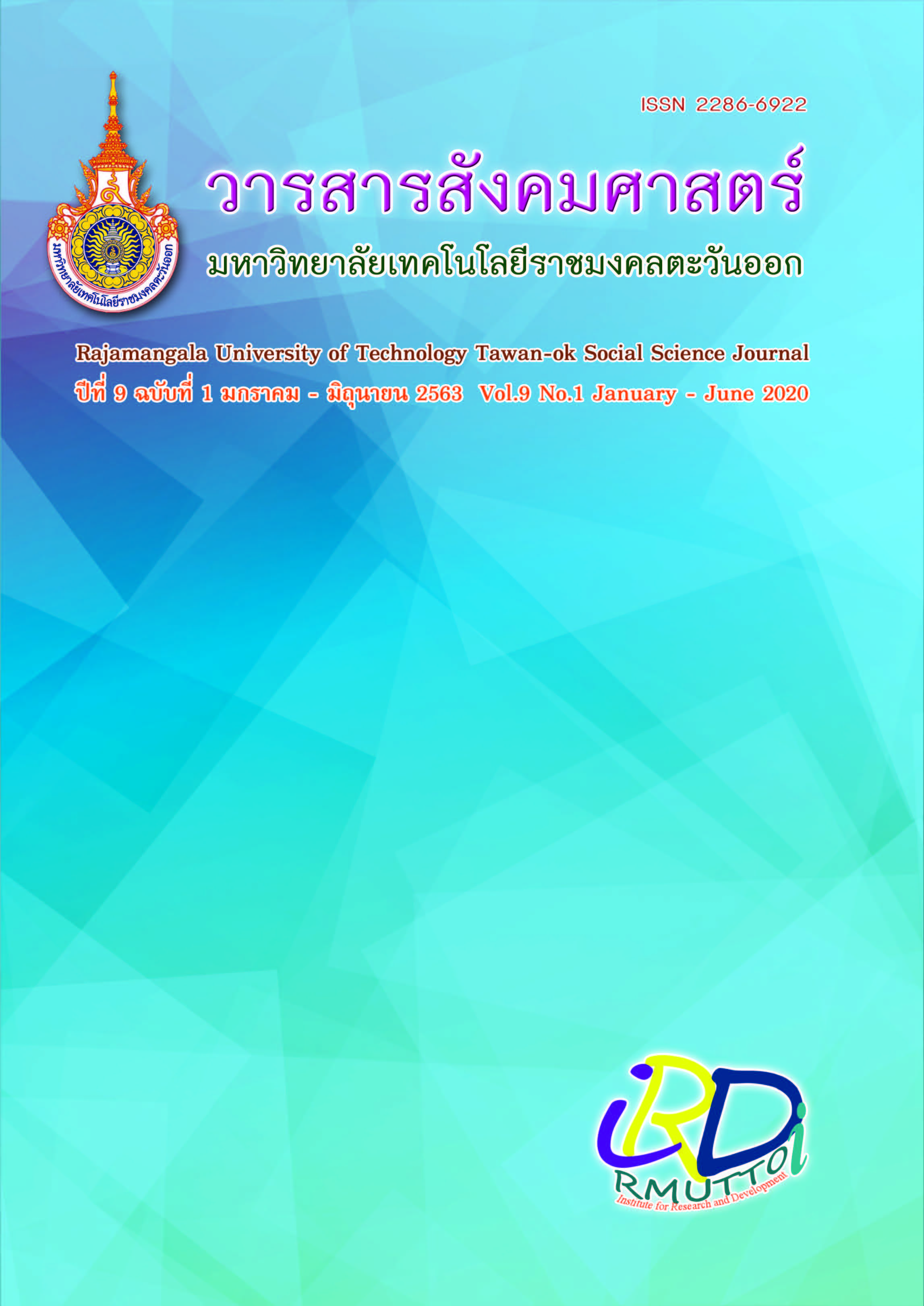Guideline on the Development of Service Quality Pearl-Milk-Tea Entrepreneur for Generation Y Consumers in Bangkok
Main Article Content
Abstract
This article describes the importance of service quality with generation-Y consumers through the perspective of service providers in the Pearl-Milk-Tea businesses. This study aims to study the development guidelines of service quality with pearl-milk-tea entrepreneur for generation-Y consumers in Bangkok. The research methodology was a qualitative study on secondary data from various documents, field study, non-participatory observation and in-depth interview with stakeholders in the pearl milk tea beverage business. The data were collected totally twenty-two service providers by using semi-structured interviews for content analysis and triangulation as a conclusion. The research was found that 1) Reliability and Trust: the staff should be trained to ensure accuracy of provided information, and supported to have morale at work; 2) Assurance: promotions and conditions of the shop should be easily understood and the staff should be encouraged to have a service mind; 3) Empathy, customer care and understanding: the staff should understand the customers’ feeling and always use customer’s recommendation to improve services; 4) Responsiveness: the staff should be trained to be capable of solving immediate problems and remembering customers, particularly frequent ones; 5) Tangibility: the staff should wear polite clothing and shop
environment should be clean, and the environmentally friendly awareness of the staff should be created.
Article Details
References
กฤษติญา มูลศรี รัตนา สีดีและธิตินันธุ์ ชาญโกศล. (2559). แนวทางการพัฒนาคุณภาพการให้บริการของผู้ประกอบการธุรกิจโรงแรมประเภท 3 ดาวในประเทศไทยเพื่อรองรับนักท่องเที่ยวกลุ่มประชาคมอาเซียน. วารสารวิจัยราชภัฏเชียงใหม่. 17(1), หน้า 19-31.
จิตชุดา นรเวทางค์กุล (2557). ส่วนประสมทางการบริการและการบริหารประสบการณ์ของลูกค้าที่มีความสัมพันธ์กับความพึงพอใจและความภักดีของลูกค้ากลุ่มโรงแรมแกรนด์เซนเตอร์พอยต์. ปริญญานิพนธ์ หลักสูตรปริญญาบริหารธุรกิจมหาบัณฑิต สาขาวิชาการตลาด มหาวิทยาลัยศรีนครินทรวิโรฒ. (ฉบับสำเนา)
ชัยสมพล ชาวประเสริฐ (2552). การตลาดบริการ. พิมพ์ครั้งที่ 12. กรุงเทพฯ: ซีเอ็ดยูเคชั่น.
ธิตินันธุ์ ชาญโกศล (2558). นวัตกรรมการบริการในแผนกบริการอื่นของธุรกิจโรงแรม หน่วยที่ 12. เอกสารการสอนชุดวิชานวัตกรรมการบริการในธุรกิจโรงแรมและภัตตาคาร. นนทบุรี: มหาวิทยาลัยสุโขทัยธรรมาธิราช.
ธีรกิติ นวรัตน์ ณ อยุธยา (2544). การตลาดบริการ. เชียงใหม่: ภาควิชาการตลาด คณะบริหารธุรกิจ มหาวิทยาลัยเชียงใหม่.
พิสิทธิ์ พิพัฒน์โภคากุล (2561). [ออนไลน์]. การสร้างประสบการณ์ในการบริการ (Service Experience) กลยุทธ์สู่การแข่งขันยุคใหม่. [สืบค้นเมื่อวันที่ 1 ธันวาคม 2562] จาก www.impressionconsult.com
ภาวิณี ทองแย้ม (2560). ความสำคัญของคุณภาพการบริการต่อความสำเร็จของธุรกิจ. วารสารเกษมบัณฑิต. 18(1), หน้า 219 -230.
มนตรี ศรีวงษ์ (2562). [ออนไลน์]. ประวัติศาสตร์ชานมไข่มุกที่โลกต้องรู้. [สืบค้นเมื่อวันที่ 5 ธันวาคม 2562] จาก http://www.thaismescenter.com/ประวัติศาสตร์-ชานมไข่มุก-ที่โลกต้องรู้/
เยาวเรศ คุ้มภัย (2561). คุณภาพการบริการของร้านกาแฟ คาเฟ่อเมซอน ในอำเภอหาดใหญ่ จังหวัดสงขลา. การค้นคว้าอิสระ. หลักสูตรปริญญาบริหารธุรกิจมหาบัณฑิต มหาวิทยาลัยรามคำแหง.
วีรพงษ์ เฉลิมจิระรัตน์ (2547). วิธีการแก้ปัญหาในงานตามแบบฉบับญี่ปุ่น. พิมพ์ครั้งที่ 9. กรุงเทพฯ: สํานักพิมพ์สมาคมส่งเสริมเทคโนโลยี (ไทย-ญี่ปุ่น).
สถาบันพัฒนาและสนับสนุนผู้ประกอบการ SME (2557). [ออนไลน์]. 9 แนวทางสร้างความเชื่อมั่นให้กับลูกค้า. [สืบค้นเมื่อวันที่ 5 ธันวาคม 2562] จาก https://taokaemai.com/9-step-customer-satisfaction/
สราวุธ พุฒนวล (2562). แนวทางการพัฒนากลยุทธ์ทางการตลาดของผู้ประกอบการธุรกิจร้านกาแฟ ในจังหวัดระนอง. รายงานวิจัยมหาวิทยาลัยราชภัฏสวนสุนันทา.
สุทธิสินี ถิระธรรมสรณ์ ภิญญาพัชญ์ นาคพิบาล และวงศ์ธีรา สุวรรณิน (2561). รูปแบบคุณภาพการบริการ ภาพลักษณ์องค์กรที่ส่งผลต่อความตั้งใจเชิงพฤติกรรมของผู้บริโภคธุรกิจสปาในประเทศไทย. วารสารราชภัฏเพชรบูรณ์สาร, 20(1) หน้า 18-32.
สุนันทา ทวีผล (2550). ความพึงพอใจของประชาชนที่มีต่อการให้บริการด้านให้คำปรึกษาแนะนำปัญหาด้านกฎหมายของสำนักงานอัยการพิเศษฝ่ายช่วยเหลือทางกฎหมาย 3 (สคช.). (สาขาวิชาการบริหารทั่วไป). วิทยาลัยการบริหารรัฐกิจ มหาวิทยาลัยบูรพา.
Economic Intelligence Center (2014). กลยุทธ์มัดใจผู้บริโภค Gen Y. [สืบค้นเมื่อวันที่ 1 ธันวาคม 2562] จาก
https://www.scbeic.com/th/detail/file/product/130/dzi68owq5l/8372_20141112161337.pdf
Global link. (2019). ชานมไข่มุกเครื่องดื่มที่ฆ่าไม่ตาย. [สืบค้นเมื่อวันที่ 5 ธันวาคม 2562] จาก https://businesslinx.globallinker.com/bizforum/article/ชานมไข่มุกเครื่องดื่มที่ฆ่าไม่ตาย/24016
Morgan, M.R., & Hunt, S. (1994). The commitment-trust theory of relationship marketing. Journal of Marketing, 58(3), pp.20-30.
Parasuraman, P.A., Zeithaml, A.V., & Berry, L.L. (1988). SERVQUAL: A Multiple-item scale for measuring consumer perceptions of service quality. Journal of Retailing, 64, pp.12-40.


